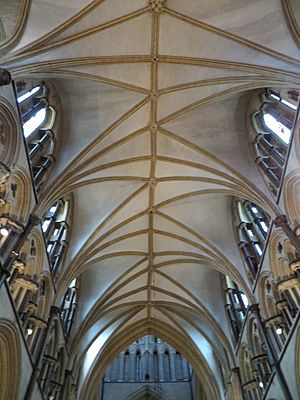Geoffrey de Noiers facts for kids
Geoffrey de Noiers was a very skilled builder known as a master mason in the late 1100s. He is famous for designing a special part of Lincoln Cathedral in England. This part is called St. Hugh's Choir.
Contents
Who Was Geoffrey de Noiers?
Geoffrey de Noiers was likely from France, specifically the Normandy region. He learned his building skills there. A master mason was like an architect and lead builder all in one. They were in charge of designing and overseeing the construction of huge buildings like cathedrals.
Designing Lincoln Cathedral's Choir
Between 1192 and 1200, Geoffrey de Noiers worked on the design for St. Hugh's Choir at Lincoln Cathedral. This part of the cathedral was actually built a bit later, around 1208. His design was very new and exciting for its time.
The "Crazy Vaults" Innovation
One of the most amazing things Geoffrey de Noiers created was a unique ceiling design called "vaulting." Imagine the ceiling of a grand hall, shaped like a series of arches. His design for the choir's vaulting was truly special.
- Decorative Vaulting: This was the first time such a fancy, decorative vaulting style was used in England.
- Skewed Ribs: He added extra stone ribs to the ceiling. These ribs made the usual four-part (quadripartite) sections of the vault look a bit twisted or offset. People even called them "crazy vaults" because they looked so unusual and cool!
- Tierceron Ribs: Geoffrey de Noiers was also the first to use something called "tierceron" ribs in Gothic vaulting. These are extra ribs that extend from the main supports, adding more patterns and strength to the ceiling.
Influence on English Gothic Style
Geoffrey de Noiers's work at Lincoln Cathedral was a big deal. His new ideas for vaulting influenced many other builders. Later English architects took his concepts and made them even more detailed and grand. This helped create a unique English Gothic building style.
Who Came After Geoffrey?
After Geoffrey de Noiers, another talented builder named Alexander the Mason took over at Lincoln Cathedral. Alexander continued to innovate, creating even more complex star-shaped vaulting designs in the cathedral's nave (the main part of the church).


